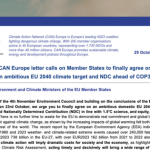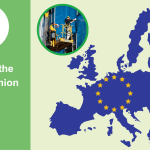The role of hydrogen in Europe’s energy transition has become a significant topic of debate in recent months. This paper aims to set out Climate Action Network Europe’s position on hydrogen, including production, appropriate end uses and infrastructure considerations.
To be in line with science and the 1.5°C objective of the Paris Agreement, Europe needs to reach climate neutrality by 2040. A full decarbonisation of the economy will require the EU to halve energy demand and triple primary energy supply from renewables by 2050, by integrating significant amounts of renewable energy sources into all sectors (industry, buildings, transport etc). This means achieving at least 65% greenhouse gas emission cuts, 45% energy savings and a 50% share of renewable energy by 2030 [1]. It will also require a high level of direct electrification of the heating and cooling and transport sector. A prerequisite to reach these goals will be to integrate a circular economy approach.
Even if the EU achieves the above climate and energy targets and implements important circularity and resource use reduction efforts, in certain sectors energy demand that cannot be met by direct electrification will remain. Hydrogen and its derivatives [2] could supply up to one-fifth of the EU’s final energy demand in 2050 (rising from 566 TWh in 2030, i.e. 6% of the EU’s final energy demand, up to 1109 TWh in 2050) [3]. Hydrogen, if produced from renewable electricity, is one of the most promising technologies for meeting this need. However, as renewable hydrogen is not a primary source of energy but an energy carrier requiring conversion from renewable electricity and implying important energy losses, we can consider it a limited resource, needing reflection on its development and use and its ability to deliver at the scale and speed necessary.
Given that today almost all hydrogen comes from fossil fuels, there is a significant risk that the European hydrogen sector could fail to shift completely to renewable hydrogen and instead becomes a way to justify continued investments in fossil fuels and maintaining legacy or building new infrastructure that should instead be decommissioned.
Access the full CAN Europe’s position on Hydrogen.
[1] See CAN Europe’s and EEB’s PAC Scenario report which describes an EU climate neutrality pathway by 2040. For instance, final energy demand will almost be halved and go down from more than 12,000 TWh in 2015 to approximately 6,000 TWh by 2050.
[2] Liquid synthetic fuels, renewable ammonia.
[3] PAC scenario, technical summary p.40.



